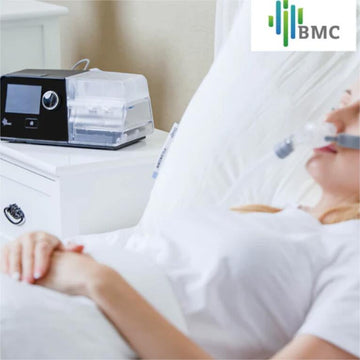When using CPAP equipment, we usually meet various common problems, today this article helps you figure out the right maintenance ways.

Common problems
Problem 1: Dirty or Moldy Equipment
Problem 2: Worn Out or Damaged Parts
Over time, the parts of your CPAP machine can become worn out or damaged, affecting its performance. This can include the mask, tubing, humidifier, and filters.
Problem 3: Incorrect Cleaning Techniques
Using the wrong cleaning agents or not following the manufacturer's instructions can damage your CPAP machine or not clean it thoroughly. For example, harsh chemicals can damage the mask or tubing, while not cleaning the humidifier can lead to bacteria growth.
Solutions
Solution 1: Regular Cleaning
The most effective way to avoid problems with your CPAP machine is to clean it regularly. This includes washing the mask, tubing, and humidifier daily, and replacing the filters as recommended by the manufacturer.
Cleaning your CPAP machine on a regular basis is critical for several reasons. First, it helps prevent the buildup of bacteria, mold, and other harmful particles that can accumulate in the machine over time. This can lead to unpleasant odors, respiratory problems, and even infections if left unchecked.
Additionally, a dirty CPAP machine can reduce the effectiveness of your therapy, meaning you may not be getting the full benefits of the treatment. Over time, this can cause your sleep apnea symptoms to worsen, leading to increased fatigue, decreased concentration, and other health issues.
To avoid these problems, it's important to follow the manufacturer's instructions for cleaning and maintenance. This typically involves washing the mask, tubing, and humidifier daily with mild soap and water, and allowing them to air dry. It's also important to replace the filters as recommended, as these can become clogged with debris and reduce the airflow of the machine.
By following these simple steps, you can ensure that your CPAP machine stays clean, effective, and safe to use. And if you do encounter any problems, there are steps you can take to troubleshoot and fix them on your own.
Solution 2: Replacing Parts
If you notice that parts of your CPAP machine are worn out or damaged, it's important to replace them promptly. This includes things like the mask cushion, tubing, and filters. While it may be tempting to continue using a damaged part, this can compromise the effectiveness of your therapy and even put your health at risk.
For example, a damaged mask cushion can cause air to leak out, reducing the effectiveness of your therapy and potentially causing skin irritation or other issues. Similarly, a worn-out filter can allow harmful particles to enter your airway, leading to respiratory problems and other health issues.
To avoid these problems, it's important to regularly inspect your CPAP machine and replace any parts that show signs of wear or damage. This may involve ordering replacement parts from the manufacturer or working with a certified provider to ensure that you get the right parts for your specific machine.
By taking proactive steps to maintain your CPAP machine, you can ensure that it continues to provide effective therapy and improve your quality of life. So don't neglect the importance of regular cleaning and maintenance, and always be on the lookout for signs of wear or damage.
Solution 3: Correct Cleaning Techniques
It's important to clean the machine thoroughly, ensuring that all parts are free of dirt, dust, and other contaminants. This may involve disassembling the machine and washing each part separately, or using specialized cleaning tools like brushes and wipes to clean hard-to-reach areas.
In addition to following the manufacturer's instructions, it's also important to use the right cleaning products and techniques. For example, harsh chemicals like bleach or ammonia can damage the machine and should be avoided. Similarly, using hot water or exposing the machine to high temperatures can cause the plastic parts to warp or crack.
To make cleaning your CPAP machine easier and more convenient, consider investing in a specialized cleaning machine. These devices use advanced cleaning techniques like UV light or ozone to kill bacteria and other germs, providing a more thorough and efficient cleaning than traditional methods.
Overall, by following the manufacturer's instructions and using the right cleaning products and techniques, you can ensure that your CPAP machine stays in good condition and provides effective therapy for years to come. So make sure to prioritize regular cleaning and maintenance, and don't hesitate to seek professional help if you have any questions or concerns.
Cleaning and disinfecting CPAP equipment is a simple process that can be done at home. Here are the steps to follow:
How to clean CPAP equipment correctly?
Step 1: Gather Your Supplies
Before you begin cleaning and disinfecting your CPAP equipment, you will need the following supplies:
- Mild dish soap or CPAP cleaning solution
- Distilled water
- Clean, lint-free towel or paper towel
- Disinfectant solution (such as vinegar and water solution, hydrogen peroxide solution, or CPAP cleaning wipes)
Step 2: Disassemble the Equipment
To clean and disinfect your CPAP equipment, you will need to disassemble it first. Remove the mask, tubing, and any other detachable parts from the machine.
Step 3: Clean the Equipment
Wash the mask, tubing, and any other detachable parts in warm, soapy water. You can use mild dish soap or a CPAP cleaning solution to clean them. Rinse the parts thoroughly with distilled water and let them air dry on a clean, lint-free towel or paper towel.
Step 4: Disinfect the Equipment
After cleaning, it's time to disinfect the equipment. You can use a disinfectant solution, such as a vinegar and water solution, hydrogen peroxide solution, or CPAP cleaning wipes. Follow the manufacturer's instructions for the disinfectant solution you choose. Make sure to thoroughly disinfect all parts of the equipment, including the mask, tubing, and machine.
Step 5: Reassemble the Equipment
Once the equipment is clean and disinfected, reassemble the mask, tubing, and any other detachable parts. Make sure all the connections are secure and snug.
Step 6: Clean the Machine
To clean the CPAP machine, wipe it down with a damp cloth or CPAP cleaning wipes. Do not submerge the machine in water or use any cleaning solutions on it. Let the machine air dry.
How to Store Your CPAP Equipment?
Here are some additional tips to help you store your CPAP equipment properly:
- Keep your CPAP equipment out of reach of children and pets.
- Avoid using harsh chemicals or cleaning agents that can damage your equipment.
- Consider investing in a travel bag or case to protect your CPAP equipment while on the go.
- Store your CPAP equipment in a place that is easily accessible, so you can find it quickly when you need it.


